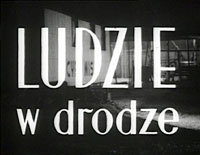 Ludzie w drodze
Ludzie w drodze
Poland, 1960, black and white, 10 mins
A companion-piece to Kazimierz Karabasz’ The Musicians/Muzykanci (1960), and made at roughly the same time, People on the Road takes a similar approach to circus folk. Both films look at what happens between performances – in The Musicians’ case, it’s a band rehearsal, while People on the Road takes us from the dismantling of the circus paraphernalia to the start of a new show in a different town. In both cases, there is no commentary and very little dialogue, none of it important (so the poorly-synced subtitles in the only current DVD edition are less of a problem than they might otherwise be) – both the camera and viewer are observers rather than critics.
The opening montage echoes that of The Musicians, in that it shows people at the end of a working day, the soundtrack consisting entirely of clanking, hammering and the thrum of internal combustion engines as everything from the large metal ‘Cyrk’ sign to the marquee to the seating is carefully disassembled and laid out piece by piece in the circus trucks. When they’ve finished, and a motley procession drives past the camera, we hear a mournful harmonica solo that will play throughout most of the remainder of the film. The performers of the Cyrk Miś (literally ‘Bear Circus’) – men, women, children, monkeys, cats and other species – either sleep en route, or lie in the juddering trucks under the flickering lights, watching the animals playing with each other or the toys dangling from the roofs.

The next day, work starts early in the middle of a large field. A trainer climbs into the cage with three muzzled bears. The men band together to erect the marquee, pushing the supporting poles into place. Makeshift kitchens and bathrooms are constructed in the open air. A monkey licks the juices off a slice of lemon. The horses are tethered on a long enough leash to allow them to run around. High-wire and trapeze artists, acrobats and unicyclists, gingerly rehearse their acts. Around all this, family life maintains a semblance of normality: mothers wash clothes and hang them on the line as children play, or pop into the marquee to gawp at the performers, getting a sneak preview before the audience proper arrives. Crowds gather, and wait in anticipation. And then the start of the performance is announced, the audience applauds, the music strikes up… and the film ends.
As that précis suggests, this is a film that thrives and indeed relies on small but inexplicably telling details – in much the same way that The Musicians did, but on a larger scale. The absence of any meaningful dialogue or narration means that all we know about these people is what their gestures tell us, but these are often highly evocative – a fleeting sidelong glance between two performers reveals a whole lexicon of information. PWA’s booklet quotes Karabasz: “What we learned, which until then had been an important but abstract postulate, was the need for discretion. We also began to understand the seemingly obvious value of patience when observing human behaviour”. Accordingly, Karabasz and his regular cinematographer Stanisław Niedbalski often shot through telephoto lenses, to avoid distracting the performers – the resulting flattening of perspective occasionally creating the alarming impression that the trapeze artist is about to collide with the unicyclist.

Three sequences run longer than average. In the first, an acrobat dresses himself, smoking a cigarette throughout, while balancing on his head – which he does with such quiet serenity and seeming obliviousness of the world around him that it’s easy to share Karabasz’ rapt fascination. The second extended sequence involves a montage of children’s faces as they wait for the performance to begin: it’s a study in anticipation and growing excitement as they peer over rails to try to get the best vantage point. And finally, there’s the elaborate sequence of pre-performance preparation, as make-up is applied, costumes adjusted and limbs stretched and flexed: we’ve already had a private view, but now they have to face a paying public, and the anxiety on the faces of some of these seasoned professionals is palpable. With barely a word of dialogue (and none of it important), Karabasz gives us a vivid glimpse of the lives of these people, and by the end we understand better why they choose to live such a nomadic and eccentric existence.
- Director: Kazimierz Karabasz
- Camera: Stanisław Niedbalski
- Sound: Halina Paszkowska
- Editing: Lidia Zonn
- Music: Jerzy Wojciechowski
- Production Co-ordinator: Ryszard Żerański
- Production Company: Wytwórnia Filmów Dokumentalnych (Documentary Film Studio)
The transfer on PWA’s DVD Polish School of the Documentary: Kazimierz Karabasz (Region 0 PAL) is generally fine in terms of picture and sound, but marred – as with their presentation of The Musicians – by subtitles that appear several seconds too late. However, the film is perfectly comprehensible if they’re switched off altogether, which may be the best bet. Culture.pl‘s overview of Karabasz’ career mentions People on the Road briefly.